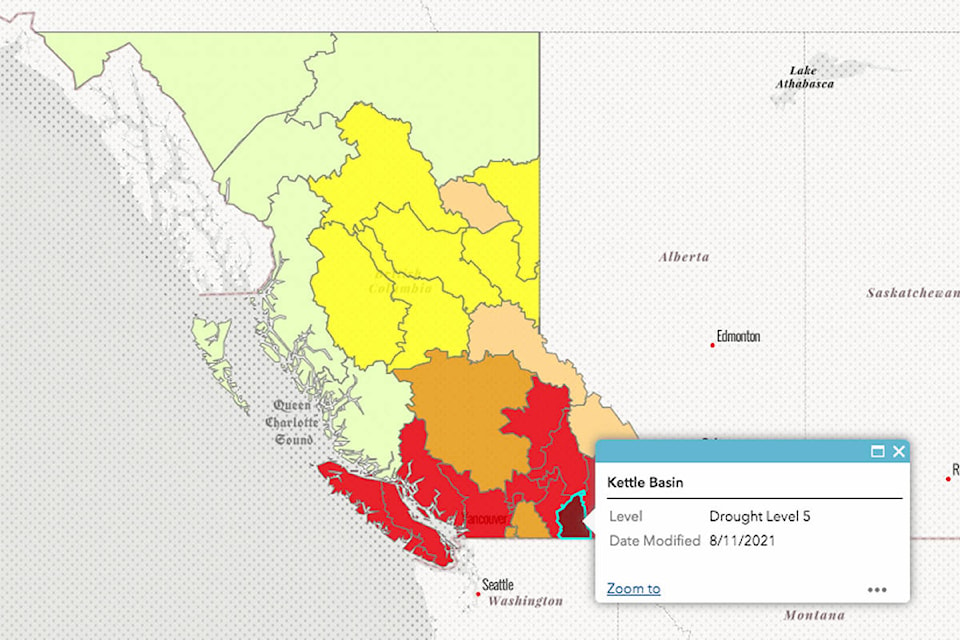This summer’s heat waves are profoundly affecting wildlife and aquatic ecosystems across the Kettle River Basin, according to wildlife and water planning officials.
Fish and birds are especially hit hard, Conservation Officer (CO) Kyle Bueckert told The Gazette Thursday, Aug. 12. Highlighting that all rivers and streams are closed to fishing across the region, Bueckert said he and his fellow COs would give no quarter to anyone caught flouting the ban.
VIDEO: Grand Forks residents, Conservation Service Officer save poisoned eagle
READ MORE: Another heat wave set to bake B.C., adding to wildfire concerns in southern regions
“If a Conservation Officer finds you angling in any river in Region 8 (including all of Grand Forks and the Regional District of Kootenay Boundary (RDKB), you can expect a fine under the BC Sports Fishing regulations.”
Bueckert went on to explain that large numbers of fish are being overheated to death in the Kettle and Granby rivers. This hugely impacts animals that prey on fish, especially eagles. It would be bad enough if the birds couldn’t find enough fish and other animals to eat, only he explained that birds of prey take in most of their water from the things they eat.
With fewer fish to eat, eagles and other birds of prey are at much higher risks of dehydration.
“When critters are hunkering down to avoid these crazy heat waves, that impacts predators as well,” he said.
Dale Belvedere, manager at the SORCO-Raptor Rehabilitation Centre (SORCO) in Oliver, honed in on that point in her interview with The Gazette Friday, Aug. 13. Raptors (e.g., eagles, hawks, ospreys and owls) are especially hindered because fish have taken to swimming closer to stream and river bottoms, where the water is cooler. Any raptor that takes a full dive into a body of water would very likely drown, she said.
READ MORE: Heavier smoke, heat likely to return to Grand Forks
READ MORE: Drought Level 4 prompts water restrictions across the Boundary
The centre was especially busy during the so-called “heat dome” that sent regional temperatures into the mid-40s and higher early last month. SORCO took in over 40 birds of prey stricken with heat exhaustion, dehydration and starvation in 48 hours starting July 4, she said. Three of the birds, all golden eagles, were brought in by Bueckert, who found them in Grand Forks, Christina Lake and Castlegar.
Most of those birds, including Bueckert’s eagles, have since recovered and have been re-released into the wild, she said, adding that some birds are still being treated at the centre.
The entire Kettle River basin has been at Drought Level 5 since Aug. 5, according to the province’s Drought Information Portal. For context, RDKB Watershed Planner Kristina Anderson noted that Level 5 is the highest of B.C.’s six ascending levels of drought, which start at Level Zero. A 53 square-kilometre stretch of the West Boundary’s Nine-Mile Creek reached Drought Level 4 on Wednesday, Aug. 11, she added.
Revisiting the human impacts she explained to The Gazette last month, Anderson stressed that this summer’s heat waves are steadily depleting Grand Forks’ surface water and groundwater reserves, which go toward drinking water for people and irrigation for livestock and agriculture.
She then echoed Bueckert and Belvedere’s concerns about fish and birds. Aquatic ecosystems throughout the Kettle River basin are under stress on account of lower water levels and higher water temperatures, adding that these impacts can be worse in areas where wetland vegetation is thin or denuded altogether. On top of hurting fish and birds, Anderson said these conditions are also hurting area amphibians like frogs and salamanders. These species live, hunt and spawn in and around stream and river beds, which are drying out.
Bueckert and Anderson each warned that heat and aridity are likely to send dangerous wildlife, especially bears, down from the hills, where berries are drying up, and into wetter, more urban areas along the Kettle and Granby rivers. Bueckert is reminding people to properly secure their food, garbage and compost and to pick up fruit under backyard trees.
“As much as it’s tough for people to deal with the heat and smoke, we have to also think about that from an animal’s perspective,” he said.
The federal government’s Water Survey of Canada announced Tuesday, Aug. 10 that it has installed water temperature monitors at its Granby, Kettle and West Kettle stations, which also measure water levels. Anderson said this was significant because most survey stations simply measure water levels.
@ltritsch1
laurie.tritschler@grandforksgazette.ca
Like us on Facebook and follow us on Twitter.
laurie.tritschler@boundarycreektimes.com
Like us on Facebook and follow us on Twitter.
